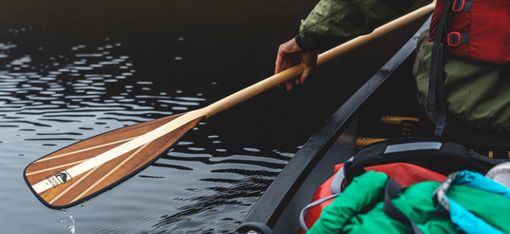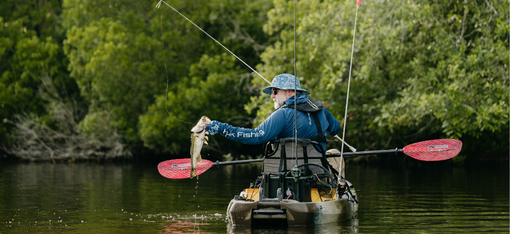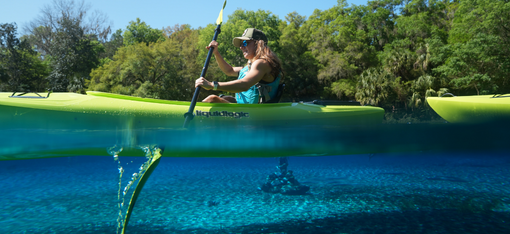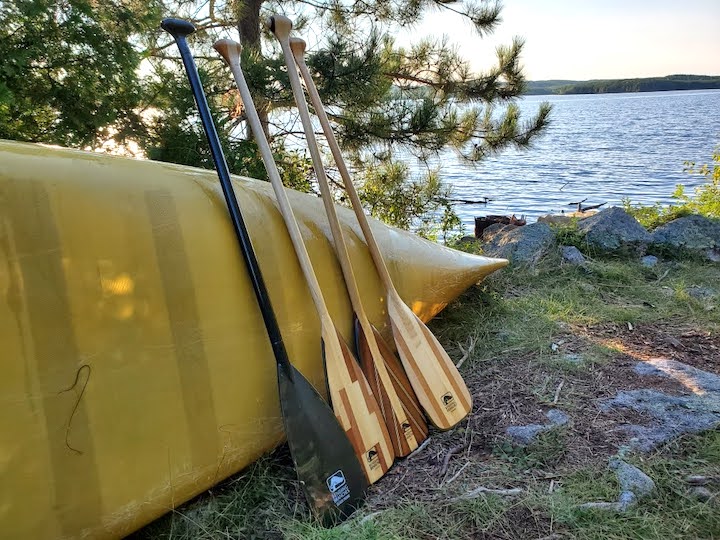Paddles for the Solo Canoeist

There are a couple different paddle options for solo canoeists we’ll discuss here: single-blade paddles (traditional canoe paddles) and double-blade paddles (commonly used with kayaks).
But first…How Is a Solo Canoe Different from a Tandem Canoe?
- Solo canoes are shorter, anywhere from 10-16 feet long. Tandem canoes are generally 16-18 feet long. A shorter canoe is much easier to control when you paddle alone.
- Solo canoes have one seat that’s centered in the boat, while tandems have a seat both in the bow and stern. A central seat gives you more control.
Pros and Cons of a Single-Blade Canoe Paddle
Paddle choice can be very personal for canoeists, and some simply prefer using a traditional single-blade canoe paddle with a canoe.
A single-blade canoe paddle is much easier to use when you’re paddling and maneuvering in tight spaces. It’s much shorter than a double-bladed paddle and easier to handle.
When canoeists are adept at the various strokes needed to steer in all conditions, it’s a joy to use a single-blade paddle. It takes a degree of skill that’s very satisfying.

Having just the one blade often means switching from side to side in these kinds of conditions. That can get tiring pretty quickly. And whenever your paddle isn’t in the water (between every stroke), the wind has a second or two to move your canoe around.
Pros and Cons of a Double-Blade Paddle
If you deal with aches, pains or injuries will find the double-blade paddle easier on your shoulders. There’s no need to switch sides of the boat as you paddle.
Some solo canoeists who are out for long days find a double-blade paddle to be more fatiguing. These paddles are heavier, there’s an extra blade catching wind (unless you feather your blades) and the paddle is much longer.

It’s easy to control your solo canoe with a double-bladed paddle (photo courtesy of Greg R.)
Why Use a Solo Canoe Paddle Instead of a Kayak Paddle?
Because you sit higher in a canoe than a kayak, your paddle needs to be longer so you can comfortably reach the water. Most kayak paddles stop at 240 or 250 cm, which isn't long enough for many solo canoeists.
NOTE: If you paddle a pack canoe you may be able to use a kayak paddle. The seats of pack canoes sit lower than traditional canoes so your paddle can be shorter.
The Best of Both Worlds
This is an especially great idea for a multi-day trip. Some canoeists even go so far as to bring a single-blade straight shaft, a single-blade bent shaft and a double-blade solo canoe paddle.
Our Single-Bladed Paddles for Solo Canoeists
Any of our canoe paddles will work for you if you opt for a single-blade paddle. We always recommend choosing the lightest paddle you can afford that will meet the conditions where you plan to canoe.
If you’re an aggressive canoeist and will do wilderness trips regularly in rough conditions, you’ll want one with a fiberglass wrap on the blade for extra protection. We have several to choose from in both straight and bent shafts, some with a lighter 2-ounce wrap and some with a tougher 4-ounce wrap.

(photo courtesy of Paul Villecourt)
If most of your solo canoeing will be at the family cabin or local lakes and rivers where you know conditions are kinder on gear, one of our non-glassed paddles will suit you just fine.
If you’d like to go super-light with your single-blade paddle then you’ll want to check out our carbon options. The Sunburst 11 and Sunburst ST (bent and straight shafts) combine beautiful woods with a carbon shaft. The Black Pearl 11 and Black Pearl ST (bent and straight shafts) are our lightest paddles at just 16 ounces. They feature a foam-core carbon blade and 100% carbon shaft and grip.
Our Double-Bladed Paddles for Solo Canoeists
We also have many options for double-bladed paddles for solo canoeists, including our entire line of kayak fishing paddles (listed from lowest to highest price for your convenience):
- Bounce: Available in lengths up to 240cm, the Bounce is a nice entry-level paddle for the casual solo canoeist. Polypropylene blades and an aluminum shaft and snap-button ferrule.
- Sunrise Glass: Available in lengths up to 240cm, the Sunrise Glass is designed to be the higher-end of recreational paddles. Polypropylene blades and fiberglass shaft with snap-button ferrule.
- Angler Ace: Available in lengths up to 280cm, the Ace has a full carbon shaft and carbon/nylon blades. It’s the ideal combination of lightweight performance with amazing durability. It’s available with both snap-button and our adjustable-length Versa-Lok™ ferrule.
- Impression Solo: Our double-blade paddle made specifically for solo canoeists, the Impression is a beautiful blend of basswood and red alder with a solid basswood shaft. It has a snap-button ferrule and comes in lengths of 260 or 280cm.
- Navigator: Available in lengths up to 240cm, this is one of our best sellers for solo canoeing given the optimal combination of traditional woods with modern carbon shaft technology. Ideal for enthusiasts or long-distancing tripping. Available in both a snap-button and our Versa-Lok™ ferrule.
- Angler Pro: Available in lengths up to 280cm, the Angler Pro is the most popular and desired paddle in the fishing community. It’s gorgeous fiberglass blades are available in three eye-catching color patterns, coupled with an extremely light but durable carbon shaft. Available in snap-button and Versa-Lok™.
- Angler Navigator: Available in lengths up to 280cm, the Angler Navigator is inspired by the original Navigator, but with adaptions for kayak fishing. Same beautiful wood blades and carbon shaft. Available in snap-button and Versa-Lok™.
- Angler Pro Carbon: Available in lengths up to 280cm, the Angler Pro Carbon is the lightest angler paddle we make, designed for extended trips and those looking to save every available ounce. Available in snap-button and Versa-Lok™.

(photo courtesy of Alexis Outdoors)
Aqua Bound’s Double-Blade Paddles for the Solo Canoeist
Our sister site, Aqua Bound, also has a great selection of paddles for the solo canoeist to choose from. These are all available in lengths up to 260cm with the snap-button ferrule and up to 255cm with the Versa-Lok™ ferrule system (which is length-adjustable):
- Sting Ray Fiberglass: The best-selling Sting Ray blade paired with an affordable fiberglass shaft.
- Sting Ray Hybrid: Aqua Bound’s best-selling kayak paddle, it features fiberglass-reinforced nylon blades and a carbon shaft.
- Sting Ray Carbon: The same popular paddle but with carbon-reinforced nylon blades to bring its weight down even further. A very nice carbon paddle for a very nice price.
- Tango Fiberglass: (new link) The gold-standard among composite blade options with stiff yet forgiving fiberglass blades and the lightest, strongest straight carbon shaft in paddles, the Tango is ideal for long-distance solo
- Tango Carbon: (new link) The lightest low-angle option available and perfect for older or long-distance canoeists. In addition to the weight savings, the overall stiffness makes every forward stroke the most impactful and enjoyable.










